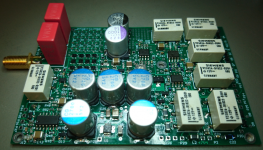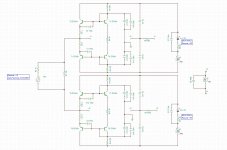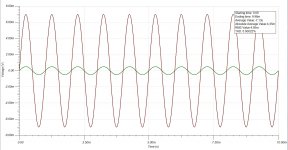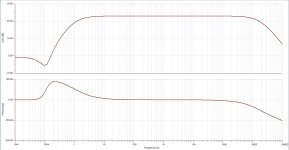They have the LT1028 since an eternity, same league.
It just has a noise molehill at 350 KHz.
You're just about the only guy that notices this.
Yesterday, the boards came from JLCPCB for the amp with
the feedback-free input stage from #1750. Couldn't help
but solder over this rainy weekend.
Either 16*BF862-SOT23-like or 16* NSVJ5908DSG5 dual FETs.
Gain & 1 lowpass frequency are cold switchable with reed relays.
40/50/60/70 dB + 0/3/6/9 fine steps.
In a previous version I had used analog switches, mixed blessing.
Runs on 2*2 Lithium cells.
The operating point is monitored with a window comparator.
If out of range, the gate resistor is reduced from 10 Meg
to 100K to speed up the process of finding back.
Takes much too long otherwise. For noise reasons input RC
must be much larger than needed for f-3dB.
The WIMAs and the relays seem to magically attract
the soldering iron. :-(
Testing will have to wait at least to next weekend.
the feedback-free input stage from #1750. Couldn't help
but solder over this rainy weekend.
Either 16*BF862-SOT23-like or 16* NSVJ5908DSG5 dual FETs.
Gain & 1 lowpass frequency are cold switchable with reed relays.
40/50/60/70 dB + 0/3/6/9 fine steps.
In a previous version I had used analog switches, mixed blessing.
Runs on 2*2 Lithium cells.
The operating point is monitored with a window comparator.
If out of range, the gate resistor is reduced from 10 Meg
to 100K to speed up the process of finding back.
Takes much too long otherwise. For noise reasons input RC
must be much larger than needed for f-3dB.
The WIMAs and the relays seem to magically attract
the soldering iron. :-(
Testing will have to wait at least to next weekend.
Attachments
Last edited:
AVX Bestcap (yellow trace) 100000uF
Only on second reading did I count the number of zeros. That's a fairly mighty capacitor!
Hi Gerhard,Yesterday, the boards came from JLCPCB for the amp with
the feedback-free input stage from #1750. Couldn't help
but solder over this rainy weekend.
Testing will have to wait at least to next weekend.
Your last posting was from one month ago.
Just curious how your project is doing, could you make any progress ?
Hans
I have not done much with it in the mean time.
Did some very short tests and noted that the NSVJ5908DSG5
dual FETs seem to have a lot of leakage current @ 3V Vds.
Normally the data sheet value of the gate current is assumed
to be limited only by the wafer tester time, but these seem
really to have that much current. For 4 pairs, i get half a Volt
drop across the 10 Meg gate resistor. No way to parallel
16 dual devices, it messes up my bias loop. I'll try the
alternate solution with 16 BF862 next, the board can use both
solutions.
The NSVJ has a nice density on the board and a low 1/f
frequency according to the data sheet. The workaround
would be a smaller gate resistor, to be paid for with more
foil capacitors in the input.
That won't be soon probably, paid design jobs are precious in
this Corona time and I scored one with high time pressure.
Involves a a lot of 10 GHz stuff and relearning ADS.
Cheers, Gerhard
Did some very short tests and noted that the NSVJ5908DSG5
dual FETs seem to have a lot of leakage current @ 3V Vds.
Normally the data sheet value of the gate current is assumed
to be limited only by the wafer tester time, but these seem
really to have that much current. For 4 pairs, i get half a Volt
drop across the 10 Meg gate resistor. No way to parallel
16 dual devices, it messes up my bias loop. I'll try the
alternate solution with 16 BF862 next, the board can use both
solutions.
The NSVJ has a nice density on the board and a low 1/f
frequency according to the data sheet. The workaround
would be a smaller gate resistor, to be paid for with more
foil capacitors in the input.
That won't be soon probably, paid design jobs are precious in
this Corona time and I scored one with high time pressure.
Involves a a lot of 10 GHz stuff and relearning ADS.
Cheers, Gerhard
Last edited:
Hi Gerhard,
Thank you for the update
May I ask why you are not using cross-correlation LF noise measurements (and trying to push the preamp to the limits)?
Thank you for the update
May I ask why you are not using cross-correlation LF noise measurements (and trying to push the preamp to the limits)?
I tried that once, my Agilent 89441A supports it. I got results
that are too good to be true. Probably operator error. There are
a lot of things to be set up. But sooner or later, I'll retry that.
that are too good to be true. Probably operator error. There are
a lot of things to be set up. But sooner or later, I'll retry that.
I’ve been using my QA401 to do noise measurements on a new MC/MM pre. Very hard to get consistent results because of environmental factors. I can get up to 4 dB variation one day to next on the spot noise floor a.though the integrated noise is much more consistent.
The QA noise floor is about -155 dBV (50 averages and 1.46 Hz bins).
The QA noise floor is about -155 dBV (50 averages and 1.46 Hz bins).
Kindly permit me to drop the level of discussion by quite a few octaves.
Am trying to do a couple of Hawking's to sit in front of a Paradise to accommodate MC's with different DC resistances.
RL provides a skimpy table for matching resistors to the cartrige in his 2014/02/04 article MCamp.doc & pdf, but i am not sure whether this still applies to the Hawking? If there is a formula i did not find it, but that is not easy in 179 pages.
Thank you.
Am trying to do a couple of Hawking's to sit in front of a Paradise to accommodate MC's with different DC resistances.
RL provides a skimpy table for matching resistors to the cartrige in his 2014/02/04 article MCamp.doc & pdf, but i am not sure whether this still applies to the Hawking? If there is a formula i did not find it, but that is not easy in 179 pages.
Thank you.
An acute case of brain fade. because - as a friendly member pointed out - the Paradise already does MC? Sorry about that mistake.
Unfortunately i can no longer edit my post, but the question stands as asked since i have a few TT's, and MC's which need a step-up to MM level.
Unfortunately i can no longer edit my post, but the question stands as asked since i have a few TT's, and MC's which need a step-up to MM level.
This is the "Matching" paragraph from the RL article referred to earlier:
---------------
Matching
The two earlier versions ran 0.5mA and were actually optimised for 20-25R MC cartridges. At that time (1980 - 1990), even without correct matching, they were still quieter than any other device or amp I could find; including some very expensive transformers.
However, common-base has a best NF of 3dB so there are significant advantages for optimal matching including much better distortion.
Cartridge DC R1/2 Current I
24R4 68k 0.51mA
12R9 36k 0.97
6R6 18k 1.9
4R2 12k 2.9
Don’t agonise too much over this. Choose a resistor slight greater (slightly less current) if you can’t get it exact. Don’t go over 3mA. Keep the physical layout small.
--------------
A link to the (already well known) complete article is attached.
---------------
Matching
The two earlier versions ran 0.5mA and were actually optimised for 20-25R MC cartridges. At that time (1980 - 1990), even without correct matching, they were still quieter than any other device or amp I could find; including some very expensive transformers.
However, common-base has a best NF of 3dB so there are significant advantages for optimal matching including much better distortion.
Cartridge DC R1/2 Current I
24R4 68k 0.51mA
12R9 36k 0.97
6R6 18k 1.9
4R2 12k 2.9
Don’t agonise too much over this. Choose a resistor slight greater (slightly less current) if you can’t get it exact. Don’t go over 3mA. Keep the physical layout small.
--------------
A link to the (already well known) complete article is attached.
Attachments
Hi guys,
I've read this whole thread, very very interesting stuff! I'm especially intrigued by the design in post #375 by syn08. No batteries is a major plus! Actually I used the gerbers provided to order some boards. Hopefully they will arrive in a couple of weeks.
I've modified the design slightly to provide more gain (23dB) and make it balanced, see attached schemetic.
The sims I did look promising, do you think it will work in real life this way?
Many thanks!
I've read this whole thread, very very interesting stuff! I'm especially intrigued by the design in post #375 by syn08. No batteries is a major plus! Actually I used the gerbers provided to order some boards. Hopefully they will arrive in a couple of weeks.
I've modified the design slightly to provide more gain (23dB) and make it balanced, see attached schemetic.
The sims I did look promising, do you think it will work in real life this way?
Many thanks!
Attachments
Last edited:
I've been reading this exceptionally interesting thread, having been pointed in this direction by my old friend and colleague Richard Lee.
I'm not sure if this has been pointed out already in the depths of this thread, but for low coil resistance MC cartridges such as many of the the 2 ohm Ortofon SPU's, the tonearm wiring can be a significant additional source of noise.
On the assumption that the internal wiring of a typical 9" arm is 0.4 metres (measured from an old set of SME wires), and using published data, the loop resistance is:
Old SME leads, measured 1.1 ohms
VDH MSS7, from spec 1.07 ohms
VDH MC300S silver, from spec 0.19 ohms
Cardas 34AWG, from spec 0.68 ohms
Cardas 33AWG, from spec 0.54 ohms
Audio Note silver, from spec 2.3 ohms
Connections, if clean, should add about 10 milliohms per connection, adding maybe a further 40 milliohms loop resistance which should be added to the above numbers.
So for anything other than the VDH pure silver single strand, which is seriously not cheap, it is prudent to add roughly an ohm for the arm wiring and connections. The only affordable (whatever the definition of that is) sub-ohm tone arm wire is the Cardas AWG33 at 0.54 ohms loop R.
But this is only significant for the very lowest R MC cartridges. For the Denon DL103R (14 ohms) or DL103 at 40 ohms, the arm wiring R is insignificant.
Craig
I'm not sure if this has been pointed out already in the depths of this thread, but for low coil resistance MC cartridges such as many of the the 2 ohm Ortofon SPU's, the tonearm wiring can be a significant additional source of noise.
On the assumption that the internal wiring of a typical 9" arm is 0.4 metres (measured from an old set of SME wires), and using published data, the loop resistance is:
Old SME leads, measured 1.1 ohms
VDH MSS7, from spec 1.07 ohms
VDH MC300S silver, from spec 0.19 ohms
Cardas 34AWG, from spec 0.68 ohms
Cardas 33AWG, from spec 0.54 ohms
Audio Note silver, from spec 2.3 ohms
Connections, if clean, should add about 10 milliohms per connection, adding maybe a further 40 milliohms loop resistance which should be added to the above numbers.
So for anything other than the VDH pure silver single strand, which is seriously not cheap, it is prudent to add roughly an ohm for the arm wiring and connections. The only affordable (whatever the definition of that is) sub-ohm tone arm wire is the Cardas AWG33 at 0.54 ohms loop R.
But this is only significant for the very lowest R MC cartridges. For the Denon DL103R (14 ohms) or DL103 at 40 ohms, the arm wiring R is insignificant.
Craig
Hi Jan
Many of the low noise phono stages here using the ZTX wonder devices have a noise equivalent input noise of <0.3nV/rootHz, or about <5 ohms. Or on your calculation (on 20kHz B/W) -147dbV; so 5dB noisier than a 2 ohm resistor.
So running a calculation of 2 ohm cartridge plus 1 ohm tonearm leads for 3 ohms, which is -150dB.
So the cartridge leads are degrading the noise by 2dB (admittedly for the extreme 2-ohm cartridges). Which is certainly worth thinking about at the performance level of the designs in this thread.
Craig
Many of the low noise phono stages here using the ZTX wonder devices have a noise equivalent input noise of <0.3nV/rootHz, or about <5 ohms. Or on your calculation (on 20kHz B/W) -147dbV; so 5dB noisier than a 2 ohm resistor.
So running a calculation of 2 ohm cartridge plus 1 ohm tonearm leads for 3 ohms, which is -150dB.
So the cartridge leads are degrading the noise by 2dB (admittedly for the extreme 2-ohm cartridges). Which is certainly worth thinking about at the performance level of the designs in this thread.
Craig
I guess the number of owners having 2R or less MC Carts on this DIY forum who really use this Cart in combination with a self constructed pre-headamp can be counted on a few fingers.
Hans
Hans
I know 3. Two of them are not on this forum 😀
I do have a 0.6Ohm cartridge in the works. But this is just because I can. Won't make the slightest bit of real world difference.
I do have a 0.6Ohm cartridge in the works. But this is just because I can. Won't make the slightest bit of real world difference.
Hi Bill,
The question was owning AND using it on a self constructed headamp.
Does that apply ?
What Cart do you have with this low imedance, is it a MC ?
And what about loosing 2dB in S/N when remainig noise is still way below the Vinyl’s surface noise.
I would be more interested in the FR of the cabling in that situation whether it’s impedance is flat over the whole audio band
So it’s certainly a point to keep in mind..
Hans
The question was owning AND using it on a self constructed headamp.
Does that apply ?
What Cart do you have with this low imedance, is it a MC ?
And what about loosing 2dB in S/N when remainig noise is still way below the Vinyl’s surface noise.
I would be more interested in the FR of the cabling in that situation whether it’s impedance is flat over the whole audio band
So it’s certainly a point to keep in mind..
Hans
Hi Hans,
I have a few 2 Ohm or lower cartridges, all MC. A 1.6Ohm unit built around an AT33 is on its way from Russia. The 0.6 Ohms will be a rebuilt 1970s ortofon MC20 (the mk1). All for giggles and no claims of sonic anything will be made 🙂
OK on the self constructed that limits the numbers as my two friends would rely on me to build them units and you know how bad my backlog is...
I have a few 2 Ohm or lower cartridges, all MC. A 1.6Ohm unit built around an AT33 is on its way from Russia. The 0.6 Ohms will be a rebuilt 1970s ortofon MC20 (the mk1). All for giggles and no claims of sonic anything will be made 🙂
OK on the self constructed that limits the numbers as my two friends would rely on me to build them units and you know how bad my backlog is...
- Home
- Source & Line
- Analogue Source
- Richard Lee's Ultra low Noise MC Head Amp




